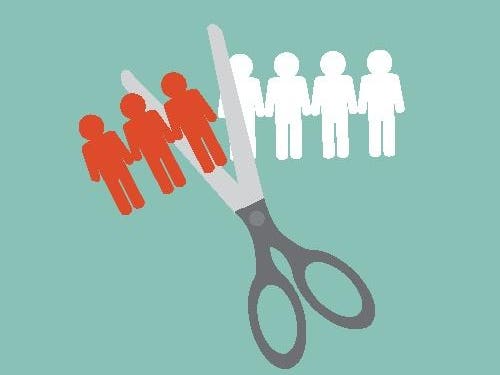Beginning early this year, companies like Meta began to champion leaner structures and efficiency. The result was layoffs, reorgs, and thinning leadership development initiatives—all of which heavily impacted middle managers.
In this interview, Al Dea breaks down the challenges and opportunities that lie in nurturing this critical tier of managers, especially in difficult times. Dea runs his own leadership training business and is the creator and host of The Edge of Work podcast, where he interviews executives, thinkers, and researchers about insights and new ideas for leading organizations and developing people in human-first ways.
The State of Middle Managers in 2023: ‘The Year of Efficiency’ Means Thin Support and Layoffs
Kevin Kruse: You wrote an interesting piece about the state of managers in 2023 earlier this year. Can you talk about organizations looking to be ‘leaner and faster’ and why they’re doing it?
Al Dea: It’s no secret that companies have faced stricter business climates. In response to these issues, many leaders started doubling down on efforts related to productivity and efficiency. The general thinking was that in difficult economic times, they felt their companies needed to cut the excess, do more with less, and hunker down.
As a result, we often saw things in the news like headlines about layoffs, reorgs, and general proclamations of a focus on productivity. Mark Zuckerberg said that 2023 was the “Year of Efficiency” at Meta and publicly shared why he decided to have Meta operate much “leaner and faster” to drive productivity and efficiency.
Kruse: How does this “productivity push” impact leadership development?
Dea: I wrote the initial article because of my belief in how important it is to keep investing in managers and give them the tools they need to be effective in their jobs, especially if companies want to improve employee productivity. McKinsey found companies that invest in managers and leading management behaviors exhibit better bottom-line performance.
I wanted to highlight that “tough times” and “investing in people” do not have to be mutually exclusive. There’s a critical business case for investing in leaders during tough times: Your managers are “force multipliers” and drive scale and impact inside organizations. It’s critical that leaders have the resources they need to do their jobs and help their companies be productive under challenging circumstances.
The Unique Role of Middle Managers: Up, Down, and Across
Kruse: The role of middle managers is so unique. Can you speak a bit about that?
Dea: When I think of middle managers, 3 words come to mind: Up, down, and across. Middle managers bridge the gap between individual contributors and upper management. Not to mention, middle managers also navigate relationships with stakeholders.
This is a ton of context-switching and role-switching. In one meeting a middle manager could go from giving strategic guidance to specific feedback for an individual contributor. They might then go to a meeting with executives to detail key projects and deliverables. This requires a nuanced and quick ability to understand the context, their role in it, and what they need to do (which can change throughout the course of a day).
In some respects, it feels like middle managers have all of the responsibility but none of the power. Take, for example, a company’s decision about returning to the office. In many cases, a middle manager won’t make the decision on what the company policy is, but they will be asked to implement and manage it for their team. But if team members have questions, concerns, or criticisms, middle managers will be the ones on the hook to sort that out, even if they had no say in the original decision.
The Unique Stressors and Challenges of Middle Management
Kruse: Why do you think it’s important to invest in middle managers, even when times are difficult and resources are scarce?
Dea: Middle managers were already one of the most challenged tiers of leaders before these reorgs, layoffs, and changes in business conditions. According to the Future Forum, middle managers were at the highest risk of burnout (43%) inside organizations. Furthermore, Humu found that many managers rated their jobs as significantly harder and were more likely than individual contributors to say that they wanted to quit.
Kruse: Why are middle managers so especially susceptible to burnout?
Dea: What I think this stems back to is the fact that we’ve begun to ask a lot of managers inside organizations, and we haven’t always been effective at matching the expectations we’ve given to them with the tools, space, time, and training they need to be effective.
One example of this comes from research by McKinsey. They found that managers were spending up to one day a week on administrative tasks, and while they believed that their highest priorities should be on talent and strategic work, they spent less time there mostly due to being overburdened with other work, like this administrative work.
Dea’s Advice for Leadership Development Professionals: Walk a Mile in the Shoes of Your Middle Managers
Kruse: What would be your advice to leadership development professionals? How can they take what you talked about throughout this interview and apply it in their work?
Dea: I would encourage leadership development professionals to go the extra mile in the intake and discovery process to truly “walk a mile in the shoes” of what it means to be a middle manager. Have a deep sense of empathy for their job and their work and truly understand their challenges, responsibilities, and aspirations. This degree of empathy can be useful in your work and in designing interventions that align with supporting middle managers in a personalized way.
This population has typically seen a lot of the foundational manager curriculum and topics, so it’s essential to rightsize it for where they are in their journey. For example, effective communication is critical for any manager’s job regardless of tenure and level, but how do you frame that in the context of talking up, down, and across? That is something that could be much more valuable for this audience.
Kevin Kruse is the Founder + CEO of LEADx, scaling and sustaining leadership behaviors with behavioral nudges, micro-learning, and live cohort based workshops. Kevin is also a New York Times bestselling author of Great Leaders Have No Rules, 15 Secrets Successful People Know About Time Management, and Employee Engagement 2.0.
Read the full article here









